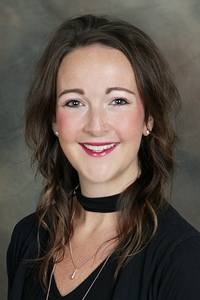By Brianna Hennen, MS, CCC-SLP, Speech Therapy
Something we do countless times every day, and take for granted until there’s a difficulty, is our ability to swallow. It is a process we don’t think about. Swallowing allows us to eat, drink, talk, and live a safe life. What happens when that ability changes due to an illness or injury?
Speech-language pathologists (SLP) play a lead role in helping individuals with dysphagia (pronounced duh·SFAY·juh). Dysphagia is a swallowing disorder involving the oral cavity (mouth), pharynx (throat), esophagus, or gastroesophageal junction. Consequences of dysphagia include malnutrition and dehydration, aspiration pneumonia, compromised general health, chronic lung disease, choking, and even death. SLPs evaluate, educate, and train individuals to improve swallow functioning, enhancing their safety and quality of life.
Approximately one in 25 adults in the United States will experience a swallowing problem each year. The prevalence of dysphagia in community-dwelling adults over 50 years is estimated to be between 15% and 22%, and in skilled nursing facilities, the prevalence rises to over 60%.
Dysphagia may develop because of stroke, traumatic brain injury, dementia, Parkinson’s disease, or other disease or developmental disability. Dysphagia may also occur from problems affecting the head and neck, such as cancer of the mouth, throat, nasopharynx, or esophagus. Radiation, trauma or surgery, and oral intubation or tracheostomy during critical care can also affect a person’s swallowing ability.
Signs and symptoms of dysphagia include:
- Drooling and poor control of food in your mouth
- Difficulty chewing
- Food or liquid remaining in the mouth after the swallow (oral residue)
- Extra time is needed to chew or swallow
- Feeling like food is “sticking” or a “fullness” in the neck
- Complaints of pain when swallowing
- Changes in vocal quality.
- Wet or gurgly sounding voice during or after eating or drinking
- Coughing or throat clearing during or after eating or drinking
- Acute or recurring aspiration pneumonia
- Changes in eating habits
- Weight loss, malnutrition, or dehydration from not being able to eat
Treatment for Dysphagia

Dysphagia treatment is often provided in the form of prevention as well as rehabilitation to improve difficulty swallowing. Speech Language Pathologists perform several tests to determine if a person has dysphagia and the severity of dysphagia. SLPs will perform imaging alongside a radiologist called a videofluoroscopic swallowing study (VFSS). This video evaluates the anatomy and physiology of the mouth, throat, and screening of the esophagus while swallowing. Based on the findings from this imaging, an individualized treatment plan is created to achieve the best possible outcome.
A speech-language pathologist often has specialized certification in Vitalstim, a therapy used to improve a patient’s swallowing muscles and reduce the risk of other medical complications associated with dysphagia. Vitalstim is a non-invasive therapy that uses external stimulation on the outside of the neck to re-educate the swallowing muscles for rehabilitation therapy. Treatment may also include training and education on safe swallowing strategies and compensatory strategies that improve safety with eating and drinking. They can also provide the individual with mouth and throat exercises to strengthen swallowing muscles.
Meet Brianna Hennen, our experienced Certified Speech Language Pathologist, who improves the lives of children and adults of all ages through speech and swallow therapy. To learn more about how speech therapy can help you or a family member, call the Therapy Services Department at 320.634.2015.


